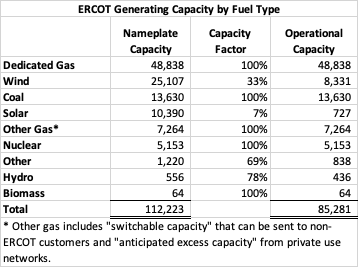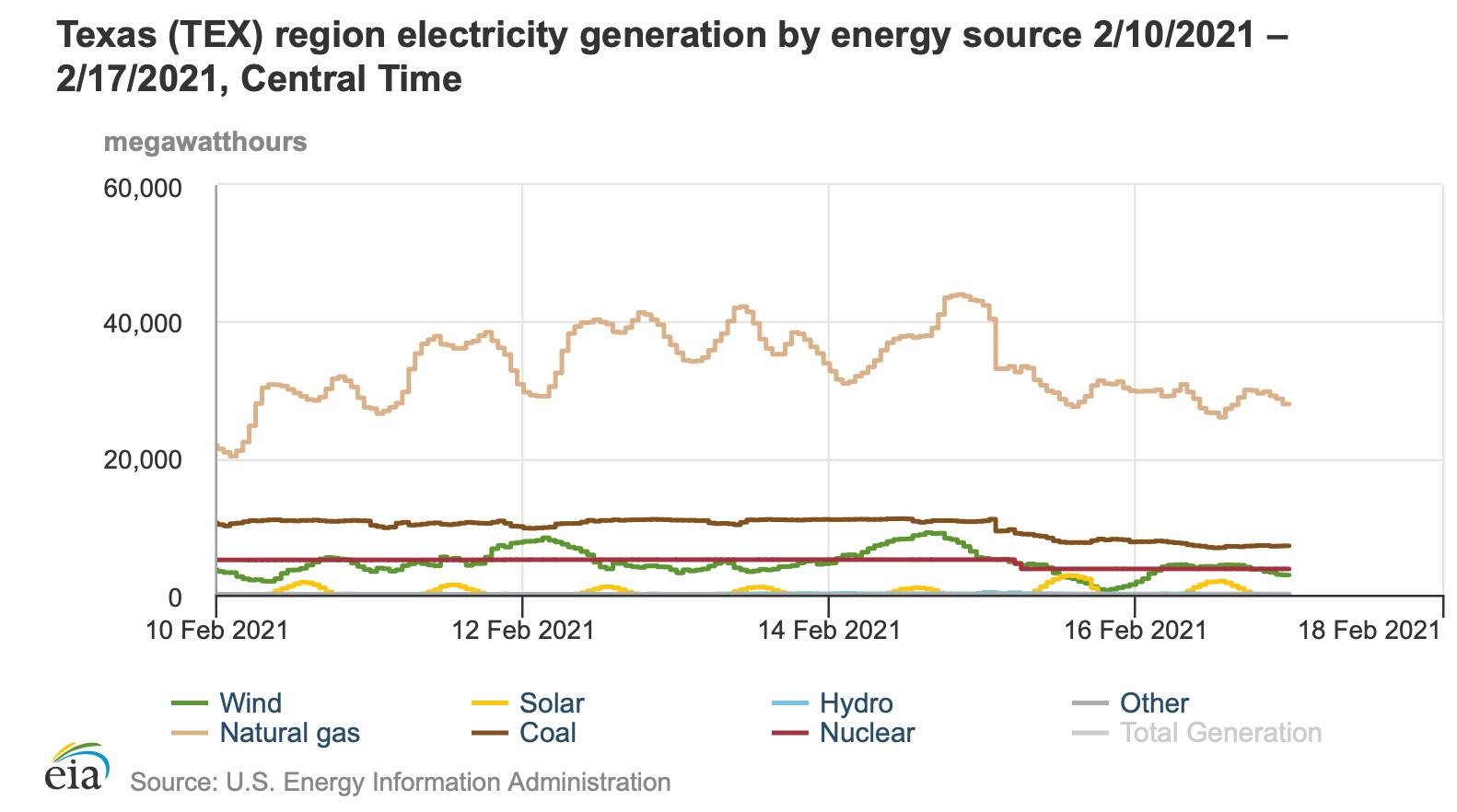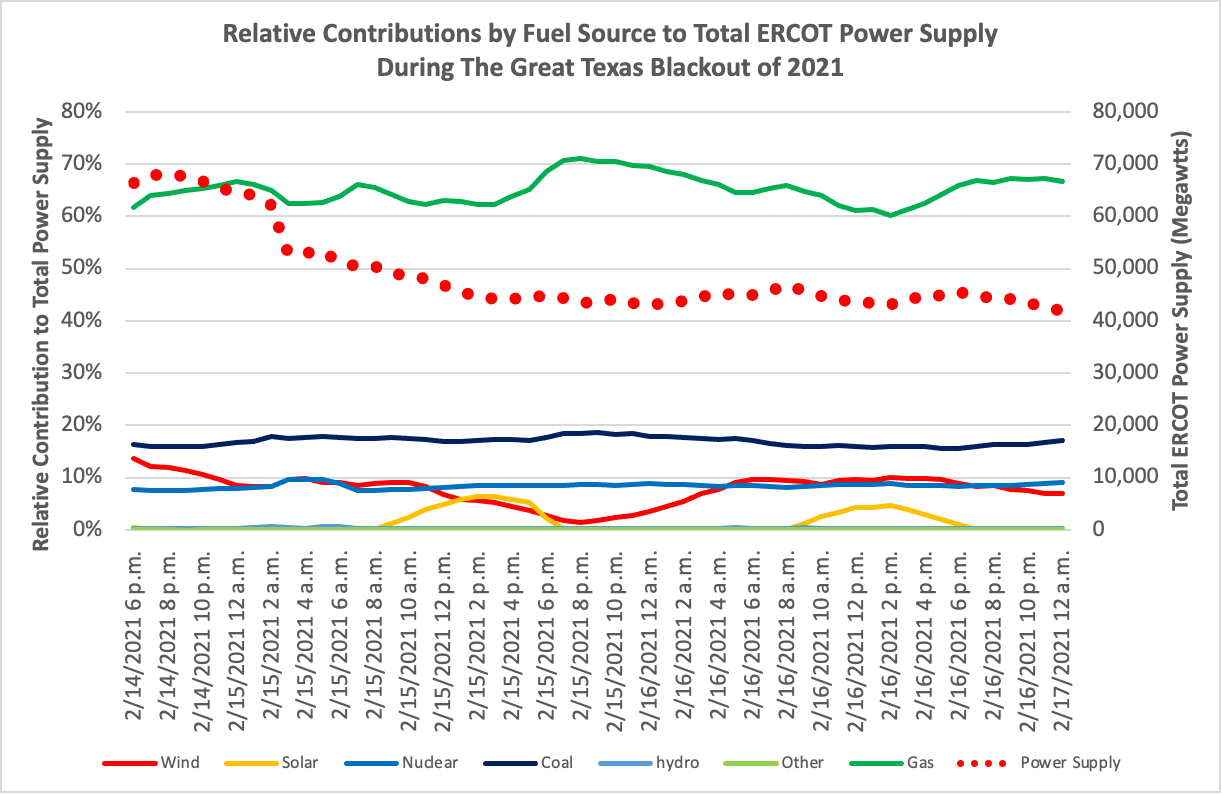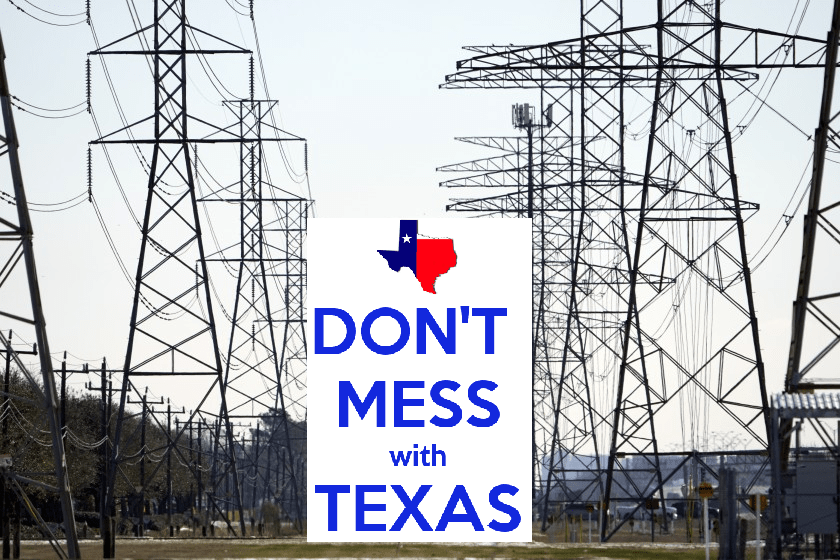Yes, with hindsight you can blame Texas for not winter weather proofing fossil fuel supplies as places do in more northern latitudes. But it was over-reliance on wind power that caused the problem and made it intractable. John Peterson explains in his TalkMarkets article How Wind Power Caused The Great Texas Blackout Of 2021. Excerpts in italics with my bolds.
- The State of Texas is suffering from a catastrophic power grid failure that’s left 4.3 million homes without electricity, including 1.3 million homes in Houston, the country’s fourth-largest city.
- While talking heads, politicians, and the press are blaming fossil fuels and claiming that more renewables are the solution, hard data from the Energy Information Administration paints a very different picture.
- The generation failures that led to The Great Texas Blackout of 2021 began at 6 pm on Sunday. Wind power fell from 36% of nameplate capacity to 22% before midnight and plummeted to 3% of nameplate capacity by 8 pm on Monday.
- While power producers quickly ramped production to almost 90% of dedicated natural gas capacity, a combination of factors including shutdowns for scheduled maintenance and a statewide increase in natural gas demand began to overload safety systems and set-off a cascade of shutdowns.
- While similar overload-induced shutdowns followed suit in coal and nuclear plants, the domino effect began with ERCOT’s reckless reliance on unreliable wind power.
The ERCOT grid has 85,281 MW of operational generating capacity if no plants are offline for scheduled maintenance. Under the “Winter Fuel Types” tab of its Capacity, Demand and Reserves Report dated December 16, 2020, ERCOT described its operational generating capacity by fuel source as follows:

Since power producers frequently take gas-fired plants offline for scheduled maintenance in February and March when power demand is typically low, ERCOT’s systemwide generating capacity was less than 85 GW and its total power load was 59.6 GW at 9:00 am on Valentines Day. By 8:00 pm, power demand has surged to 68 GW (14%). Then hell froze over. Over the next 24 hours, statewide power production collapsed to 43.5 GW (36%) and millions of households were plunged into darkness in freezing weather conditions.
I went to the US Energy Information Administration’s website and searched for hourly data on electricity production by fuel source in the State of Texas. The first treasure I found was this line graph that shows electricity generation by fuel source from 12:01 am on February 10th through 11:59 pm on February 16th.

The second and more important treasure was a downloadable spreadsheet file that contained the hourly data used to build the graph. An analysis of the hourly data shows:
- Wind power collapsing from 9 GW to 5.45 GW between 6 pm and 11:59 pm on the 14th with natural gas ramping from 41 GW to 43 GW during the same period.
- Wind power falling from 5.45 GW to 0.65 GW between 12:01 am and 8:00 pm on the 15th with natural gas spiking down from 40.4 GW to 33 GW between 2 am and 3 am as excess demand caused a cascade of safety events that took gas-fired plants offline.
- Coal power falling from 11.1 GW to 7.65 GW between 2:00 am and 3:00 pm on the 15th as storm-related demand overwhelmed generating capacity.
- Nuclear power falling from 5.1 GW to 3.8 GW at 7:00 am on the 15th as storm-related demand overwhelmed generating capacity.
The following table summarizes the capacity losses of each class of generating assets.

The Great Texas Blackout of 2021 was a classic domino-effect chain reaction where unreliable wind power experienced a 40% failure before gas-fired power plants began to buckle under the strain of an unprecedented winter storm. There were plenty of failures by the time the dust settled, but ERCOT’s reckless reliance on unreliable wind power set up the chain of dominoes that brought untold suffering and death to Texas residents.

The graph clearly shows that during their worst-performing hours:
- Natural gas power plants produced at least 60.2% of the power available to Texas consumers, or 97% of their relative contribution to power supplies at 6:00 pm on Valentine’s day;
- Coal-fired power plants produced at least 15.6% of the power available to Texas consumers, or 95% of their relative contribution to power supplies at 6:00 pm on Valentine’s day;
- Nuclear power plants produced at least 7.5% of the power available to Texas consumers, or 97% of their relative contribution to power supplies at 6:00 pm on Valentine’s day; and
- Wind power plants produced 1.5% of the power available to Texas consumers, or 11% of their relative contribution to power supplies at 6:00 pm on Valentine’s day; and
- Solar power plants did what solar power plants do and had no meaningful impact.
Conclusion
Now that temperatures have moderated, things are getting back to normal, and The Great Texas Blackout of 2021 is little more than an unpleasant memory. While some Texas consumers are up in arms over blackout-related injuries, the State has rebounded, and many of us believe a few days of inconvenience is a fair price to pay for decades of cheap electric power. I think the inevitable investigations and public hearings will be immensely entertaining. I hope they lead to modest reforms of the free-wheeling ERCOT market that prevent irresponsible action from low-cost but wildly unreliable electricity producers from wind turbines.
Over the last year, wind stocks like Vestas Wind Systems (VWDRY) TPI Composites (TPIC) Northland Power (NPIFF), American Superconductor (AMSC), and NextEra Energy (NEE) have soared on market expectations of unlimited future growth. As formal investigations into the root cause of The Great Texas Blackout of 2021 proceed to an inescapable conclusion that unreliable wind power is not suitable for use in advanced economies, I think market expectations are likely to turn and turn quickly. I won’t be surprised if the blowback from The Great Texas Blackout of 2021 rapidly bleeds over to other overvalued sectors that rely on renewables as the heart of their raison d’etre, including vehicle electrification.

Reblogged this on Climate Collections.
LikeLike